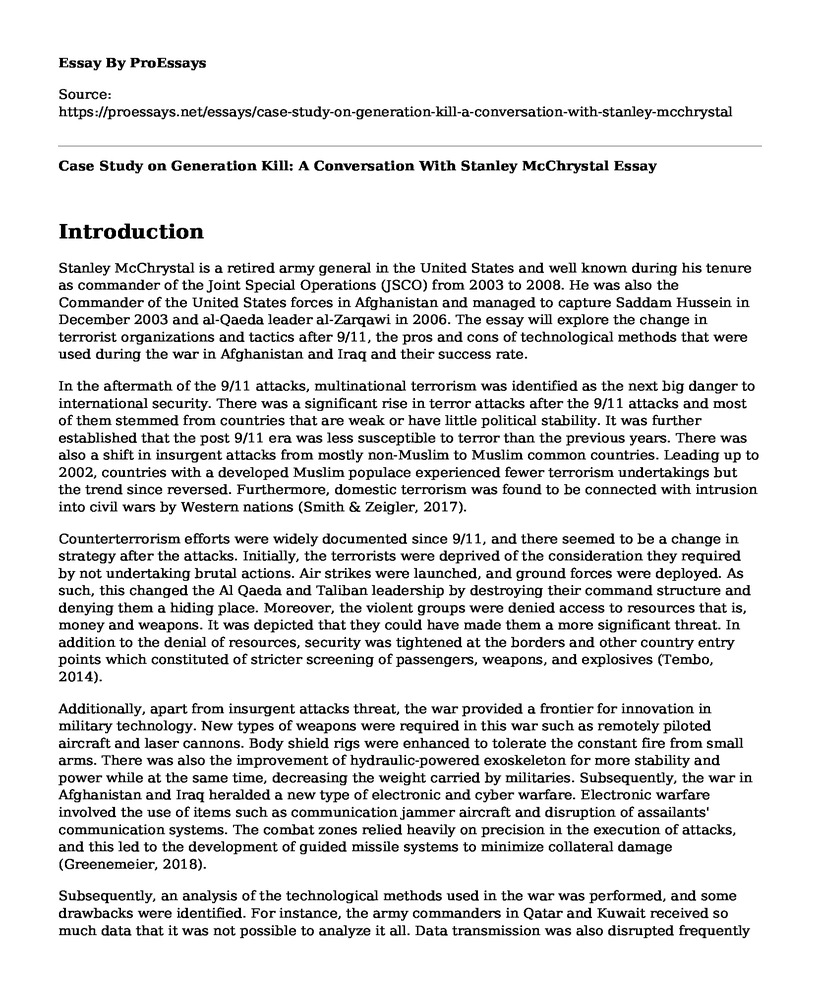Introduction
Stanley McChrystal is a retired army general in the United States and well known during his tenure as commander of the Joint Special Operations (JSCO) from 2003 to 2008. He was also the Commander of the United States forces in Afghanistan and managed to capture Saddam Hussein in December 2003 and al-Qaeda leader al-Zarqawi in 2006. The essay will explore the change in terrorist organizations and tactics after 9/11, the pros and cons of technological methods that were used during the war in Afghanistan and Iraq and their success rate.
In the aftermath of the 9/11 attacks, multinational terrorism was identified as the next big danger to international security. There was a significant rise in terror attacks after the 9/11 attacks and most of them stemmed from countries that are weak or have little political stability. It was further established that the post 9/11 era was less susceptible to terror than the previous years. There was also a shift in insurgent attacks from mostly non-Muslim to Muslim common countries. Leading up to 2002, countries with a developed Muslim populace experienced fewer terrorism undertakings but the trend since reversed. Furthermore, domestic terrorism was found to be connected with intrusion into civil wars by Western nations (Smith & Zeigler, 2017).
Counterterrorism efforts were widely documented since 9/11, and there seemed to be a change in strategy after the attacks. Initially, the terrorists were deprived of the consideration they required by not undertaking brutal actions. Air strikes were launched, and ground forces were deployed. As such, this changed the Al Qaeda and Taliban leadership by destroying their command structure and denying them a hiding place. Moreover, the violent groups were denied access to resources that is, money and weapons. It was depicted that they could have made them a more significant threat. In addition to the denial of resources, security was tightened at the borders and other country entry points which constituted of stricter screening of passengers, weapons, and explosives (Tembo, 2014).
Additionally, apart from insurgent attacks threat, the war provided a frontier for innovation in military technology. New types of weapons were required in this war such as remotely piloted aircraft and laser cannons. Body shield rigs were enhanced to tolerate the constant fire from small arms. There was also the improvement of hydraulic-powered exoskeleton for more stability and power while at the same time, decreasing the weight carried by militaries. Subsequently, the war in Afghanistan and Iraq heralded a new type of electronic and cyber warfare. Electronic warfare involved the use of items such as communication jammer aircraft and disruption of assailants' communication systems. The combat zones relied heavily on precision in the execution of attacks, and this led to the development of guided missile systems to minimize collateral damage (Greenemeier, 2018).
Subsequently, an analysis of the technological methods used in the war was performed, and some drawbacks were identified. For instance, the army commanders in Qatar and Kuwait received so much data that it was not possible to analyze it all. Data transmission was also disrupted frequently due to network problems. Also, the old-fashioned command where the sensor information went up the chain of command where it was processed before being passed down resulted in massive time delays and tough terrain (Richelson, 2018).
Lastly, there has been an explored risk of using technological capabilities against terrorists due to the possibility of acquisition of the technology by extremist groups for illegal purposes. New technology might result in increased productivity of the group's activities when it is employed such as the use of sarin gas in terrorist activities which might increase the number of lives lost. Another concern about technological consciousness of terrorist establishments is the information available on the internet. As a result of its widespread availability, it delivers a way for terror groups to escalate their expertise at low danger (Nacos, 2016).
Conclusion
The essay has highlighted the change in terrorist activities after 9/11 and the counter terrorism strategies that the United States developed in an attempt to win the war and exterminate the violent extremist groups specifically in Afghanistan and Iraq. A change in military tactics was also evident and more sophisticated technology was adopted to wage war on terror.
References
Greenemeier, L. (2018). Post-9/11 Technology Brings Exoskeletons, Laser Cannons to 21st-Century U.S. Military [Slide Show]. Retrieved from https://www.scientificamerican.com/article/post-911-military-technology/
Nacos, B. L. (2016). Terrorism and counterterrorism. Routledge.Richelson, J. T. (2018).
The US intelligence community. Routledge.Smith, M., & Zeigler, S. M. (2017). Terrorism before and after 9/11-a more dangerous world?. Research & Politics, 4(4), 2053168017739757.
Tembo, E. B. (2014). US-UK counter-terrorism after 9/11: A qualitative approach.
Cite this page
Case Study on Generation Kill: A Conversation With Stanley McChrystal. (2022, Nov 06). Retrieved from https://proessays.net/essays/case-study-on-generation-kill-a-conversation-with-stanley-mcchrystal
If you are the original author of this essay and no longer wish to have it published on the ProEssays website, please click below to request its removal:
- Causes and Effects of Bullying Essay
- Essay Sample on Racism and Discrimination of Native Peruvians
- Research Paper on Violent Crimes in the United States
- Economic Arguments in Favor and Against Conditional Cash Transfers (CCTs) Essay Example
- Essay Example on Cyber-Bullying: A Growing Threat in the Digital Age
- Evolution of Immigration Policies: Asian & Mexican Immigrants - Essay Sample
- Essay on Low-Cost Green Housing: Exploring Our Impact and Solutions







